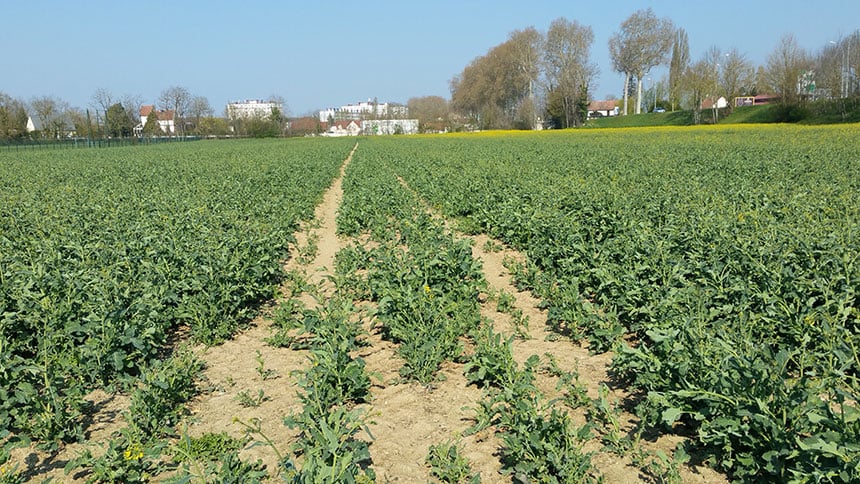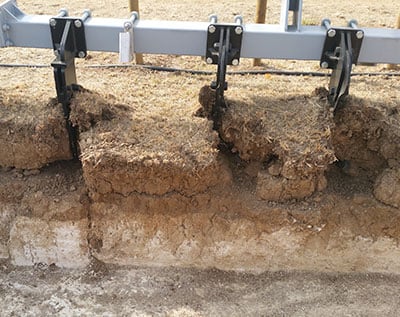Your soil is your main asset when it comes to obtaining good yields year after year. But maintaining this level of production requires special care, in particular by avoiding soil compaction during harvesting periods.
Throughout the year you try to optimise tyre pressure when working on different agricultural campaigns. But when it comes to harvest time, you bring out the combine-harvesters that weigh between 25 and 40 tonnes, with a high tyre inflation pressure, which creates a significant impact on the structure of your soil.
The passage of very heavy harvesting machines is responsible for 50 to 85% of soil compaction, depending on the type of soil and the moisture content. This compaction, accentuated by the repeated toing and froing, reduces soil permeability, thus seriously affecting its capacity to accommodate water, air, nutrients and the plant treatments necessary for good crop growth.
Losses in yield due to soil compaction may reach 20 to 40%, which is a major problem that can be managed with good practices and suitable equipment.
In this article, we explain how VF agricultural tyres can play a role in soil preservation after the harvest.
We will look at how to look ahead and prepare your soil for future sowing while minimising compaction. From the use of good tyres to optimal pressure management, discover how to restore the structure of your soil after the harvest to guarantee better, long-lasting yields.
1. Harvesting is the operation with the highest impact on your soil
Harvesting, the last step in a long production cycle, is a severe challenge for the structure of your soil. The toing and froing of heavy machinery such as combine-harvesters and trailers can effectively cause serious compaction, with negative consequences on soil health and future productivity.

Impact of the weight of the machinery and pressure to the ground
The combined weight of the agricultural machines, often over several tens of tonnes, exerts considerable pressure on the ground.
This pressure is concentrated beneath the tyres, leading to compaction of the topsoil and the deeper layers of soil. The higher the pressure, the greater the soil compaction.
The long-term effects of compaction
The negative effects of soil compaction are not immediately obvious but occur over time.
Compacted soil leads to a decrease in porosity, reducing its capacity to store water, air and nutrients. These elements, essential for the growth of the seedlings, become less accessible. This weakens the root system and limits crop development capacity.

(flowering on the right, not in the centre)
Less compaction = soil in good health = better productivity
The preservation of the soil structure ensures the health and perennity of your crops.
By avoiding compaction, you create an environment that is conducive to growth. Your seedlings will have access to the water and nutrients they need to develop vigorously and produce abundant, quality harvests.
These optimal conditions result in:
- better crop growth,
- improved yields,
- better quality production,
- a reduction in costs by avoiding soil recovery work
2. The central role of pressure in soil preservation
Why do harvesting machines work with higher pressure?
Harvesting equipment is generally heavier than other agricultural machines as part of the harvest is stored while the work is carried out, requiring a higher inflation pressure to cope with the extra load without crushing the tyres.
However, this increase in pressure accentuates the soil compaction phenomenon.
What is the link between pressure and compaction?
When an agricultural vehicle drives over the ground, the tyres exert pressure to the soil surface.
If you consider the soil as a spongey structure, the greater the pressure applied to this structure, the more compressed the pores become and the more the structure caves in. Agricultural vehicle tyres have the same effect on the soil.
- High tyre pressure = high compaction force.
- High compaction force = more pronounced soil compaction.

Deep compaction of the topsoil
Be extra careful with pressure
During harvesting, you must be very careful with your tyre inflation pressure, especially in wet conditions. Water effectively reduces the soil’s bearing capacity, which increases the risk of compaction with the same tyre inflation pressure.
Recommendations for soil preservation
During wet periods, whether for wheat or corn harvesting in October, you must adopt agricultural practices which protect the structure of your soil.
Here is some advice to avoid excess soil compaction and protect the fertility of your land:
- Do not overload the harvester: only fill it up partially.
- Avoid unnecessary loads: Remove ballast and any additional implements.
- Limit the amount of passages across the field with trailers: make more frequent trips to empty the machine at the edge of the field.
- Use cultivation techniques that improve the soil structure: direct seeding, soil cover.
- Give preference to VF tyres for all vehicles: these tyre models allow you to work with a low inflation pressure.
- Adapt tyre pressure based on the weather conditions, the type of soil and the type of work to be done.
3. How to best manage soil recovery work after the harvest?
What are the solutions for alleviating compaction after the harvest?
There are several solutions for restoring soil and preserving its fertility.
1. Soil decompaction techniques: tilling or aerating?
The choice of decompaction technique depends on the depth of the compaction:
- Surface compaction (20-25 cm): tilling is an efficient way of softening the topsoil and encouraging the infiltration of water. Be careful not to till always at the same depth to avoid creating a plough plan.

- Deep compaction (up to 60 cm): an aerator or subsoiler makes it possible to break up the soil deep down without turning it over. This technique is particularly useful for restoring soil porosity and improving drainage and for recovering the capacity to store deep water reserves for dry periods.

2. Encourage biodiversity: a natural ally
In addition to the mechanical techniques, you must stimulate the biological life within the soil to facilitate its natural regeneration. This can be done by:
- Adding organic material: compost, manure...
- Crop rotation using crops with deep roots: corn, rapeseed, broad been, radish, carrot, beet...
- Using plant cover which acts as mulch with a high cellulose content to improve the presence of earthworms. The latter are precious allies for the decomposition of organic matter and the aeration of the soil. A high worm presence in your soil makes drainage 10 times quicker.

3. Only use tyres that are compatible with soil preservation
To avoid further compaction during soil recovery work, it is highly recommended that you use VF technology low-pressure tyres.
These tyres spread the weight of the machine over a longer, larger surface area, thus reducing the impact to the ground.

Advantages of low-pressure VF tyres
- Work at low pressure.
- Better weight distribution.
- Reduction of soil compaction.
- Improvement of traction.
- Greater driving comfort
- Reduction in fuel consumption.
4. The VF VT-TRACTOR agricultural tyre to protect future yields
Bridgestone’s VF VT-TRACTOR tyre is an efficient way to preserve the structure of your soil and limit compaction. It contributes towards maintaining the fertility of your land and optimising your yields on a long-term basis.
How does the VF VT-TRACTOR tyre protect your soil?
1. Reduction of pressure to the ground
The VF VT-TRACTOR tyre is designed to work at very low pressure, between 0.6 and 0.8 bar, i.e. a pressure of up to 40% less than standard agricultural tyres.
This feature leads to a better distribution of the machine’s weight to the ground and limits compaction.
Working at low pressure allows you to respect the ground’s load bearing capacity better.

2. Bigger contact patch with the ground
With its soil footprint that is longer and larger than standard tyres, the VF VT-TRACTOR tyre offers a better load distribution when working at low pressure, which contributes to limiting soil compaction and preserving the structure of the soil.
3. VF (Very High Flexion) technology
The casing of the VF VT-TRACTOR tyre is designed using innovative materials and an innovative structure which give it an exceptional flexion capacity. This flexibility allows the tyre to change its shape beneath the load, thus spreading the weight over an even larger area and further reducing soil compaction.
4. Reduction in slip ratio
The VF VT-TRACTOR’s optimised tread profile guarantees excellent traction and limits slip, an important factor in soil preservation.
5. Increased durability
Manufactured using quality materials, this high-tech tyre is designed to withstand the extreme strain of agricultural labours. Its wear life is longer than standard agricultural tyres, which helps you save money in the long run.
Soil compaction during harvesting, generally caused by the circulation of heavy machines, has a serious effect on soil health and future productivity.This phenomenon is accompanied by many disadvantages. It decreases soil porosity, limits access to water and nutrients for plants and reduces yields and the quality of harvests.
The use of VF tyres such as Bridgestone’s VT-TRACTOR tyre helps reduce pressure to the ground by up to 40% compared to standard tyres. It is designed to improve driving comfort and respect the environment.
This tyre represents a judicious investment for all farmers concerned with protecting their soil and improving their productivity.
The Bridgestone-agriculture.eu blog is written and administered by tractor tyre experts who are available to provide you with the advice you need on the subject of your agricultural tyres. They allow you to maximise your productivity with information on all subjects linked to tyres: Cheap tractor tyres — Technical data for agricultural tyres — Air pressure advice — Solutions to avoid soil compaction — Sprayer tyre pressure — Why and how to ballast your tractor tyres — When to use dual wheels — The mechanical causes of abnormal wear — Cheap agricultural tyres – etc.
To learn more and boost your farm's profits, Bridgestone-Agriculture is offering you a free, detailed white paper that explains the essential role your agricultural tyres play in your productivity.
Most people who read this article have also read some of the following articles:
- 5 essential techniques to optimise your agricultural tyres
- What are the signs of an incorrect lead ratio?
- Impact of the dynamic rolling circumference of agricultural tyres
- What is the impact of the section width of your agricultural tyres
- Do my tractor tyres have a wide enough footprint?
- Can my agricultural tyres help reduce my fuel consumption?
- Does improper lead invalidate your agricultural tyre warranty?
- How can you manage the rolling resistance in agricultural tyres better?
- What are agricultural tyres’ high-strain zones?
- Should you change the rim for wide agricultural tyres?
This information is intended only to make you aware of the technical and functional aspects of agricultural tires and their use. It does not allow you to make a judgment or a definitive conclusion on a given problem. Only your agricultural tire expert is able to make a technical assessment and take a final decision, case by case.
Leave a
commentary
Your email address will not be published.
Required fields are indicated with *








